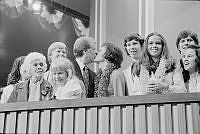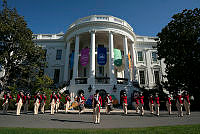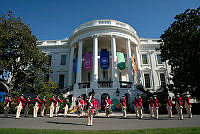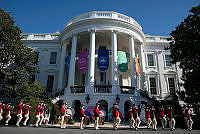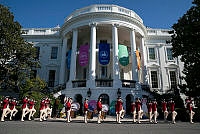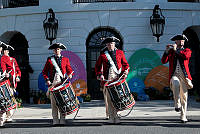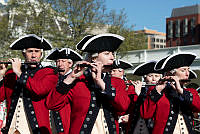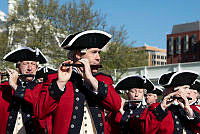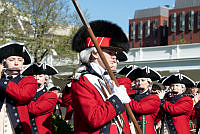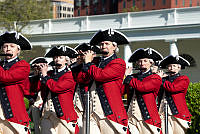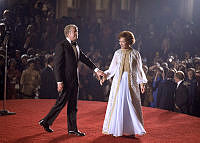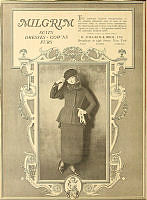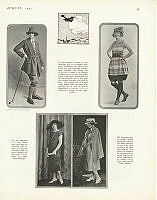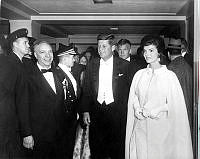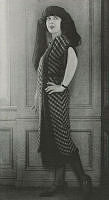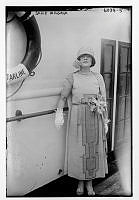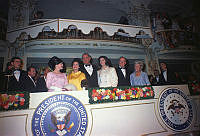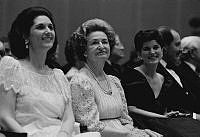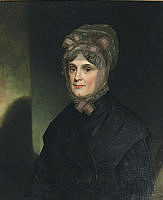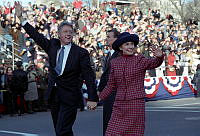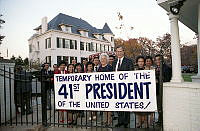A "Dark Horse" in Sunlight and Shadow
Daguerreotypes of President James K. Polk
Copyright © June 1997 White House Historical Association. All rights reserved under international copyright conventions. No part of this article may be reproduced or utilized in any form or by any means, electronic or mechanical, including photocopying, recording, or by any information storage and retrieval system, without permission in writing from the publisher. Requests for reprint permissions should be addressed to books@whha.org
When Whig opponents chanted “Who is James K. Polk?” throughout the presidential election of 1844, it was more an attempt to influence perception than a reflection of reality. The image of Polk as an obscure protege of Andrew Jackson stood in contrast to the successful career of the nationally known governor of Tennessee and speaker of the United States House of Representatives. Polk’s “dark horse” status was based not on his political obscurity, but on his unexpected selection by the Democratic party. In May 1844 the Democrats met in Baltimore, faced with the task of finding a candidate to oppose the ever-popular Henry Clay of Kentucky. Former president Martin Van Buren was initially the Democratic front runner, but neither Van Buren or his closest rivals, Lewis Cass, Richard M. Johnson, and James Buchanan, could garner enough support to secure the necessary two-thirds vote. The prospective candidates were locked in and labeled by their political ideologies, and compromise was slow in coming. Surprisingly, on the eighth ballot the intended vice presidential candidate, James K. Polk, was considered for the first office and received a single delegate’s vote. On the ninth ballot the incredible occurred. The delegates overwhelmingly threw their support behind the young Tennessee statesman. Polk had emerged from behind the pack of office seekers to become the first dark horse presidential candidate selected by a major political party.
James Knox Polk, born into modest circumstances on November 2, 1795, on the family farm in Mecklenburg County, North Carolina, was named after his maternal grandfather, a captain of militia during the American Revolution. After service in the Tennessee legislature he was elected to the United States House of Representatives and reelected six times in succession. As a faithful supporter of President Andrew Jackson he was rewarded with the chairmanship of the powerful House Ways and Means Committee, and in 1835 was elected Speaker. At the opening of the presidential campaign of 1844 it was generally believed that Henry Clay would resoundingly defeat the compromise Democratic candidate. Clay’s opposition to the annexation of Texas, however, undermined his support in the South, while Polk’s popularity grew from his position for immediate annexation, settlement of the Oregon boundary dispute, and the reduction of the tariff. In the November general election Polk captured 50 percent of the popular vote and 170 electoral ballots to become, at age forty- nine, the youngest president up to that time. Described as a hard worker and a conscientious administrator, Polk held a clear vision for his presidency. In keeping with the mode established by his mentor Andrew Jackson, Polk would dominate his cabinet, thereby increasing the powers of his office. High on the president’s agenda was the acquisition of western lands. As the architect of Manifest Destiny, Polk would double the territorial size of the United States through the annexation of Texas and the acquisition of California.

A portrait of James K. Polk attributed to Matthew Brady at the White House, February 1849. When Brady copied this portrait of President Polk and offered it commercially as a carte de visite - a visiting-card-sized photograph - the image was retouched to make the presidents appearance somewhat softer.
Library of CongressEven before James Polk took the oath of office on March 4, 1845, he was pursued by photographers. The science and art of the daguerreotype, the earliest form of photography, had advanced significantly since its introduction in France in 1839. In its primitive stages the daguerreotype, a silvered plate of copper rendered light-sensitive by exposure to iodine fumes, was photographically too slow for practical portraiture. Within a year of the announced discovery, however, inquisitive minds in all comers of the globe had devised improvements in chemistry and optics, enabling the establishment of photographic portrait galleries. Daguerreotypes were produced in great numbers in France and elsewhere in Europe. It was in America, however, that photography took on the proportions of a major industry. One of the earliest practitioners of the new science was a remarkable, energetic visionary named John Plumbe, Jr., who styled himself professor of photography.
During the first six years of the daguerreian era Plumbe had attained a national reputation by winning the highest honors in photographic competitions and by establishing a chain of twenty-five galleries extending up and down the east coast, west to the Mississippi, and down to New Orleans.1 In addition to manufacturing and importing all requisite photographic materials, Professor Plumbe gave instructions to the first generation of photographers in America. Plumbe photographed the humble and the mighty but had a particular interest in portraits of celebrities, who frequented his many fine establishments. The young reporter Walt Whitman once wrote a newspaper account of his visit to Plumbe’s elegant Broadway gallery in New York. He noted that the richly appointed walls were covered with the likenesses of distinguished statesmen, authors, musicians, actors and comedians, jurists, artists, and belles.2
Late in 1844 John Plumbe opened his new gallery in Washington, D.C., in the Concert Hall building next to the fashionable Brown’s Hotel on Pennsylvania Avenue.3 Ever seeking the carriage trade, Plumbe located his daguerreotype studio halfway between the Capitol and the President’s House. It was probably not by accident that his arrival in Washington coincided with that of President-elect Polk. A contemporary newspaper account gives evidence of Plumbe’s success:
“PLUMB’S [sic] DAGUERREAN GALLERY.
Mr. Editor: I had heard so much of late about the improvements of Professor Plumb [sic] in Daguerreotyping, that my curiosity led me to visit his specimen gallery; and the first object that attracted my attention was a likeness of the President elect, taken a few days ago. It is one of the finest specimens of this art that I ever beheld; and the Professor informed me that he was making preparations to take the likenesses of President Polk’s Cabinet, so soon as they shall be announced to the country; which fact will elicit the attention of the vast concourse of his friends who will be present at the Inauguration. I say to those, who are fond of the fine arts, that the Professor’s specimens are well worthy of their attention; and should they visit his Gallery they will be met in a gentlemanly and courteous manner.
An admirer of the fine arts.”4
Polk was not the first president to have his photograph taken while in office. Sometime between March 4 and 6, 1841, President William Henry Harrison sat for his daguerreotype likeness in the U.S. Capitol.
As early as February 1845, Plumbe was planning to photograph the new president with his cabinet. Evidently Plumbe was not the only one anxious for the president-elect to choose his advisors. The cabinet selection was one of Polk’s most vexing problems. It would take the methodical Polk three and a half months to select his six department heads. The problem of sectionalism, with the underlying and ever-present issue of slavery, gave Polk good reason to seek a balanced representation in his cabinet. Within ten days of the inauguration, Plumbe offered for sale a portrait of the newly in stalled chief executive. An advertisement in The Daily Madisonian offered “beautiful gold breast pins, containing likenesses of President Polk, furnished to order.”5 Unfortunately, neither the daguerreotype of the president-elect displayed in Plumbe’s Washington gallery or an example of the Polk breast pin have been located.
Polk was not the first president to have his photograph taken while in office. That honor goes back almost to the beginning of photography itself. Sometime between March 4 and 6, 1841, President William Henry Harrison sat for his daguerreotype likeness in the U.S. Capitol. A newspaper announcement suggests that the image could have been taken on Harrison’s fateful inauguration day. Itinerant photographers Moore and Ward prevailed upon Vice President Richard M. Johnson to provide the use of his official apartment and access to rooms of the Senate Committee on Military Affairs. According to the photographer Moore, President Harrison was “delighted with the results.” In a month’s time Harrison would be dead from pneumonia contracted during his lengthy inaugural address. This likeness of the ephemeral President Harrison has never been found.6
Early in 1846 Plumbe traveled down Pennsylvania Avenue to visit the President’s House. This time his intent was not to obtain another presidential portrait but to record an architectural view of the executive mansion. According to a newspaper report, it was Plumbe’s idea to photograph the public buildings and monuments of Washington and to exhibit them free to the public in his gallery. Further, Plumbe intended “to dispose of copies of these beautiful pictures, either in sets or singly.”7 Plumbe’s daguerreotype of President and Mrs. James K. Polk’s official residence is the earliest known photograph of the White House. This photograph, together with views of the Capitol, Patent Office, and Post Office, was discovered in California in 1973 and is now in the collection of the Library of Congress.8

South view of the President's House looking north and east: earliest known photograph of the White House, c. January 1846, President Polk's first year in office.
Library of CongressOn February 27, 1846, after slightly less than a year in office, President Polk dutifully recorded in his diary the occasion of his daguerreotype portrait:
“At the request of Mr. Shank of Cincinnati, Ohio, who was taking Daguerreotype [Vc] likenesses of the ladies of the family in one of the parlours below stairs requested to take mine for his own use, and I gave him a sitting. He took several good likenesses”9
Abel Shank was a camera man employed by John Plumbe. Early in the same year, he photographed former president John Quincy Adams at the Pennsylvania Avenue gallery.10 It is uncertain which likeness of President Polk was Shank’s, but in 1846 Nathaniel Currier published a pair of lithographic portraits of the president and first lady from daguerreotypes by Plumbe. It was a policy of the Plumbe Gallery that all of the daguerreotypes issued from its many locations (regardless of the photographer) were identified as works by PLUMBE. Plumbe pioneered the concept of brand name recognition in photography. Mathew Brady would copy the idea to great advantage ten years later. The significance of the Shank portrait of President Polk is considerable. Although we cannot with certainty identify the image, it is the earliest recorded instance of a photograph of a United States president taken in the White House. All previous images were taken either in the Capitol or in a photographer’s studio. The fact that a photographer was admitted into his family’s quarters shows the degree of accessibility President Polk allowed.
Mr. Healey [sic], the artist, requested the cabinet & myself to go into the parlour and suffer him to take a dagguerryotype [sic] likeness of the whole of us in a group. We gratified him.
With the annexation of Texas, Mexican-American relations were doomed. On May 13, 1846, Congress declared war with Mexico as a result of an engagement in a disputed region. Despite the many concerns of the war, President Polk agreed to accommodate the portrait painter George Peter Alexander Healy’s request for a likeness. After taxing the president with more than thirteen hours of sittings, Healy made a final request for a daguerreotype session. In his diary entry of June 16, 1846, President Polk recorded,
“Mr. Healey [sic], the artist, requested the cabinet & myself to go into the parlour and suffer him to take a dagguerryotype [sic] likeness of the whole of us in a group. We gratified him. We found Mrs. Madison in the parlour with the ladies. Three attempts were made to take the likeness of myself, the Cabinet, & the ladies in a group, all of which failed.”11
Although the president made note of the failed attempts to take group portraits inside the dimly lit White House, an existing daguerreotype may represent the successful work of the artist-tumed-photographer George Healy. In the collection of the International Museum of Photography at the George Eastman House is an extraordinary daguerreotype portraying President and Mrs. Polk accompanied by former First Lady Dolley Madison and the secretary of state and future president James Buchanan, with his niece the future White House hostess, Harriet Lane. The current first family is literally flanked by administrations past and future. Two prominent members of Polk’s cabinet are also part of the sunlit assembly: Cave Johnson, the postmaster general, best remembered for his introduction of the U.S. postage stamp, and Secretary of the Treasury Robert Walker, the guiding force behind the Independent Treasury System. A windowed wall of the south portico of the White House serves as a backdrop for this informal and historically significant portrait.

A gathering on the South Portico of the White House, about 1848. That most modern couple, James and Sarah Polk, are front center. The turbaned head to the president’s left is that of the by-then-legendary Dolley Madison.
George Eastman HouseJohn Plumbe’s desire to photograph President Polk and his cabinet was finally fulfilled in the spring or summer of 1846.12 By that time Polk had assumed the role of commander in chief of all U.S. military forces and was conducting a distant war. Though obviously preoccupied with matters of national consequence, the president and his advisors assembled in the State Dining Room—Thomas Jefferson’s old office—to pose for Professor Plumbe. All were present save one, the secretary of state, James Buchanan. Seated in the front row at far left was the relaxed and engaging attorney general, John Y. Mason, a Virginian who served as navy secretary in John Tyler’s administration. He would play an important role in concluding the Mexican War and be appointed to the Supreme Court by President Buchanan. Next to him sat the busy secretary of war, William L. Marcy from New York. His offhanded remark, “to the victors belong the spoils,” forever links his name with the patronage system. The president, somber and intense, placed his hand across his chest, recalling a pose more familiar to the previous century. The president, slightly less than medium height, maintained a trim figure. His eyes were large and deep set, some said piercing on occasion. A shock of black hair, turned gray by the time he took office, he wore long and combed straight back, at times spilling over his collar. Seated at far right was Secretary of the Treasury Robert J. Walker from Mississippi. Author of the Walker Tariff of 1846, he provided good counsel for the president and raised private funds to support the war with Mexico. The towering figure at center was Cave Johnson, a fellow Tennessean, longtime political ally and personal friend of the president. Johnson would serve as postmaster general throughout Polk’s administration. Standing off to the side, perhaps in an unconscious effort to distance himself from the other bureaucrats, was Secretary of the Navy George Bancroft of Massachusetts, the preeminent American historian of his day and founder of the U.S. Naval Academy. Bancroft would bolt from Polk’s cabinet in September over the morality of the Mexican War. For his loyal service Polk would appoint him U.S. minister to Great Britain.
The Plumbe daguerreotype of President Polk and cabinet holds dual historical distinctions. It is the earliest known photograph of a U.S. president with his advisors, as well as the first photographic record of a White House interior. Architectural historian William Seale observes:
“[The photograph] shows white- painted woodwork, which was customary throughout the house, and a highly figured, though not strongly contrasting wallpaper. The State Dining Room chairs appear in the Cabinet photograph. These were in the mode popularly known as “French antique” or Louis Quatorze. One of Monroe’s marble mantels from Italy crosses the back of the picture, and there are impressions of a basketlike chandelier made of glass beads reflected in the huge mirror that hangs over it. A faint pattern is discernible in the wallpaper. The carpeting is decorated with flowers.”13

President Polk and his cabinet assembled in the State Dining Room. An image of dual historical significance: the earliest photographic record of a White House interior and the first photograph of a U.S. President and his advisors.
James K. Polk MemorialThe demands of office during the war with Mexico appear to have restricted President Polk’s time. Constantly besieged by office seekers and immersed in the details of his administration, Polk curtailed appointments with portraitists. It was not until January 12, 1848, two weeks before the signing of the Treaty of Guadalupe Hidalgo in Mexico signified an end to hostilities, that Polk agreed to sit for another daguerreotype. John Plumbe once more arrived at the President’s House and set up his photographic equipment in the State Dining Room, where he took Polk’s portrait.14 No specific likeness can be attributed to that sitting, but the dramatic half-length, semiprofile daguerreotype portrait of James and Sarah Childress Polk, presently owned by the James K. Polk Home in Columbia, Tennessee, bears many of the familiar hall marks of Plumbe’s work.15 The image was given to the museum by a descendant of Mrs. Polk, though its history has long been obscured. In 1910 the image was reproduced as a frontispiece for volume 3 of The Diary of James K. Polk with a notation that it was taken in Washington in 1847 or 1848.16
A year after Plumbe’s visit to the executive mansion, Mathew Brady of New York arranged for several sittings with President Polk. Realizing that the self- proclaimed one-term president was about to leave office, Brady hastened to photograph the popular statesman. On February 14, 1849, Brady secured permission to convert the State Dining Room into a temporary photo graphic studio.17 Two days later Brady returned, this time to record the president and cabinet members James Buchanan and John Y. Mason.18 Encouraged by his rapport with the president, Brady called the very next day for another session. President Polk detailed the event in his diary entry for February 17, 1849:
“The Cabinet met at the usual hour; all of the members present except the Secretary of War ... in consequence of indisposition. Before entering on any business the members of the Cabinet at my request accompanied me to the large dining room below stairs & set for their Daguerrotype [sic] likenesses. Mr. Brady, the artist, desired to take the Cabinet & myself in a group and did so.”19
A single daguerreotype portrait of President Polk attributed to the sittings of February 1849 has survived. This handsome, half-length portrait of the resolute president is now in the Mathew Brady Collection at the Library of Congress. In the early 1860s Brady copied the daguerreotype onto a glass plate negative and sold carte de visite photographic prints of the former president. More recently, a vignette version of the Brady portrait was depicted on a United States thirty-two cent stamp to commemorate Polk’s 200th birthday.

President and Mrs. James K. Polk, one of the youngest and most handsome couples to enter the White House.
James K. Polk Ancestral Home CollectionPresident Polk was succeeded by the victorious Mexican War general Zachary Taylor. Polk regarded his successor, thrust into office by the Whigs, as “wholly unqualified for the station,” being “without political information and without experience in civil life.20 ”Nonetheless, on inauguration day, Monday, March 5, 1849, Polk took the new president by the hand and expressed his desire that the country would prosper under Taylor’s leadership. To commemorate the transfer of power, Brother Jonathan, a popular periodical of the day, carried an ambitious woodcut illustration of the event. The fanciful composite shows President Taylor surrounded by a crowd of well- wishers, including Millard Fillmore, John Tyler, Daniel Webster, John Calhoun, Sam Flouston, two Indian chiefs, and several Supreme Court justices. A note of explanation accompanies the engraving:
“President Taylor Delivering His Inaugural Speech, on the Steps of the Capitol. With Portraits by Matteson, of some of the Most Distinguished Statesmen, Soldiers, Citizens and Ladies Now at the Seat of Government. These portraits, be it remembered, are perfect likenesses of the distinguished individuals they represent; for they are exact facsimile of daguerreotypes taken from life by the great artist Plumbe; and this is an assurance for their fidelity, which places them beyond question or cavil.”21
Standing behind President Taylor on the inaugural platform are former President and Mrs. James K. Polk. Their portrait is a primitive rendering from a lovely daguerreotype. The pose is reminiscent of an earlier White House portrait taken by Plumbe. With this published portrait the circle was completed; John Plumbe had photographed Polk as president-elect, several times at the White House during his most turbulent days in office, and now the last image of Polk as he prepared to leave Washington for retirement. On the day he left the White House Polk confided in his diary, “I feel exceedingly relieved that I am now free from all public cares.”22 The former president returned to Nashville, then went on a triumphant tour of the South, where he fell ill and died, possibly from cholera, less than four months after leaving office.
James K. Polk has been appraised as the greatest one-term president. His pursuit of Manifest Destiny and his adherence to fiscal responsibility expanded and strengthened the republic. During his term several important technological developments helped shape the future of the nation—the expansion of the interstate railroad system, the invention and utilization of the magnetic telegraph, and the universal application of photography. President Polk was the first chief executive to be photographed repeatedly. His willingness to accommodate photographers, even into the White House, speaks of his sense of historical awareness. Through the perseverance and artistry of pioneer photographers John Plumbe, George Healy, Mathew Brady, and others, a vivid and personal record of the illustrious “dark horse” has been preserved for future generations.













